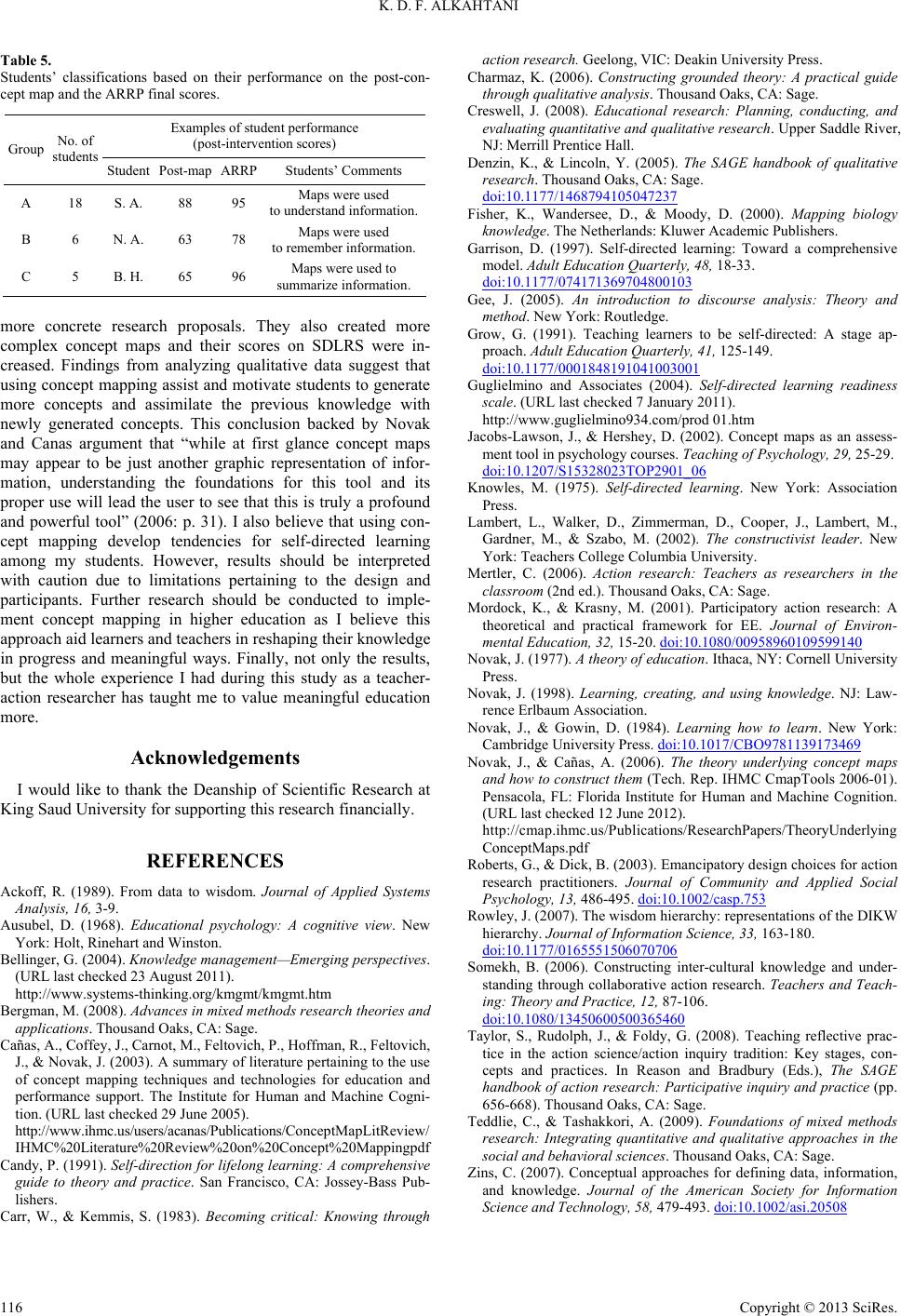
K. D. F. ALKAHTANI
Table 5.
Students’ classifications based on their performance on the post-con-
cept map and the ARRP final scores.
Examples of student perfo rmance
(post-interve nti on s c ore s)
Group No. of
students Student Post-map ARRP Students’ Comments
A 18 S. A. 88 95 Maps were used
to understand information.
B 6 N. A. 63 78 Maps were used
to remember information.
C 5 B. H. 65 96 Maps were use d to
summarize in f o rmation.
more concrete research proposals. They also created more
complex concept maps and their scores on SDLRS were in-
creased. Findings from analyzing qualitative data suggest that
using concept mapping assist and motivate students to generate
more concepts and assimilate the previous knowledge with
newly generated concepts. This conclusion backed by Novak
and Canas argument that “while at first glance concept maps
may appear to be just another graphic representation of infor-
mation, understanding the foundations for this tool and its
proper use will lead the user to see that this is truly a profound
and powerful tool” (2006: p. 31). I also believe that using con-
cept mapping develop tendencies for self-directed learning
among my students. However, results should be interpreted
with caution due to limitations pertaining to the design and
participants. Further research should be conducted to imple-
ment concept mapping in higher education as I believe this
approach aid learners and teachers in reshaping their knowledge
in progress and meaningful ways. Finally, not only the results,
but the whole experience I had during this study as a teacher-
action researcher has taught me to value meaningful education
more.
Acknowledgements
I would like to thank the Deanship of Scientific Research at
King Saud University for supporting this research financially.
REFERENCES
Ackoff, R. (1989). From data to wisdom. Journal of Applied Systems
Analysis, 16, 3-9.
Ausubel, D. (1968). Educational psychology: A cognitive view. New
York: Holt, Rinehart a n d Winston.
Bellinger, G. (2004). Knowledge management—Emerging perspectives.
(URL last checked 23 August 2011).
http://www.systems-thinking.org/kmgmt/kmgmt.htm
Bergman, M. (2008). Advances in mixed methods research theories and
applications. Th o usand Oaks, CA: Sage.
Cañas, A., Coffey, J., Carno t, M., Feltovich , P., Ho f fman, R., Feltovich,
J., & Novak, J. (2003). A summary of literature pertai ning to the use
of concept mapping techniques and technologies for education and
performance support. The Institute for Human and Machine Cogni-
tion. (URL last checked 29 June 20 05).
http://www.ihmc.us/users/acanas/Publications/ConceptMapLitReview/
IHMC%20Literature%20Review%20on%20Concept%20Mappingpdf
Candy, P. (1991). Self-direction for lifelong learning: A comprehensive
guide to theory and practice. San Francisco, CA: Jossey-Bass Pub-
lishers.
Carr, W., & Kemmis, S. (1983). Becoming critical: Knowing through
action research. Geelong, VIC: Deakin University Press.
Charmaz, K. (2006). Constructing grounded theory: A practical guide
through qualita t i ve analysis. Thousand Oaks, CA: Sage.
Creswell, J. (2008). Educational research: Planning, conducting, and
evaluating quantitative and qualitative research. Upper Saddle River,
NJ: Merrill Prentice Hall.
Denzin, K., & Lincoln, Y. (2005). The SAGE handbook of qualitative
research. Thousand Oaks, CA: Sage.
doi:10.1177/1468794105047237
Fisher, K., Wandersee, D., & Moody, D. (2000). Mapping biology
knowledge. The Netherlands: Kluwer Academic Publishers.
Garrison, D. (1997). Self-directed learning: Toward a comprehensive
model. Adult Educatio n Quarterly, 48, 18-33.
doi:10.1177/074171369704800103
Gee, J. (2005). An introduction to discourse analysis: Theory and
method. New York: Routledge.
Grow, G. (1991). Teaching learners to be self-directed: A stage ap-
proach. Adult Education Quarterly, 41, 125-149.
doi:10.1177/0001848191041003001
Guglielmino and Associates (2004). Self-directed learning readiness
scale. (URL last checked 7 January 2011).
http://www.guglielmino934.com/prod 01.htm
Jacobs-Lawson, J., & Hershey, D. (2002). Concept maps as an assess-
ment tool in psychology c o urses. Teaching of Psychology, 29, 25-29.
doi:10.1207/S15328023TOP2901_06
Knowles, M. (1975). Self-directed learning. New York: Association
Press.
Lambert, L., Walker, D., Zimmerman, D., Cooper, J., Lambert, M.,
Gardner, M., & Szabo, M. (2002). The constructivist leader. New
York: Teachers College Columbia University.
Mertler, C. (2006). Action research: Teachers as researchers in the
classroom (2nd ed.). Thousand Oaks, CA: S a g e .
Mordock, K., & Krasny, M. (2001). Participatory action research: A
theoretical and practical framework for EE. Journal of Environ-
mental Education, 32, 15-20. doi:10.1080/00958960109599140
Novak, J. (1977). A theory of education. Ithaca, NY: Cornell University
Press.
Novak, J. (1998). Learning, creating, and using knowledge. NJ: Law-
rence Erlbaum Association.
Novak, J., & Gowin, D. (1984). Learning how to learn. New York:
Cambridge University Press. doi:10.1017/CBO9781139173469
Novak, J., & Cañas, A. (2006). The theory underlying concept maps
and how to construct them (Tech. Rep. IHMC CmapTools 2006-01).
Pensacola, FL: Florida Institute for Human and Machine Cognition.
(URL last checked 12 June 2012).
http://cmap.ihmc.us/Publications/ResearchPapers/TheoryUnderlying
ConceptMaps.pdf
Roberts, G., & Dick, B. (2003). Emancipatory design choices for action
research practitioners. Journal of Community and Applied Social
Psychology, 13, 486- 495. doi:10.1002/casp.753
Rowley, J. (2007). The wisdom hierarchy: representations of the DIKW
hierarchy. Journal of Information S c ience, 33, 163-180.
doi:10.1177/0165551506070706
Somekh, B. (2006). Constructing inter-cultural knowledge and under-
standing through collaborative action research. Teachers and Teach-
ing: Theory and Practice , 12, 87-106.
doi:10.1080/13450600500365460
Taylor, S., Rudolph, J., & Foldy, G. (2008). Teaching reflective prac-
tice in the action science/action inquiry tradition: Key stages, con-
cepts and practices. In Reason and Bradbury (Eds.), The SAGE
handbook of action research: Participative inquiry and practice (pp.
656-668). Thous and O aks, CA: Sage.
Teddlie, C., & Tashakkori, A. (2009). Foundations of mixed methods
research: Integrating quantitative and qualitative approaches in the
social and behavioral sciences. T h o u s a nd O a k s , CA: Sage.
Zins, C. (2007). Conceptual approaches for defining data, information,
and knowledge. Journal of the American Society for Information
Science and Technology, 58, 479-493. doi:10.1002/asi.20508
Copyright © 2013 SciR es .
116